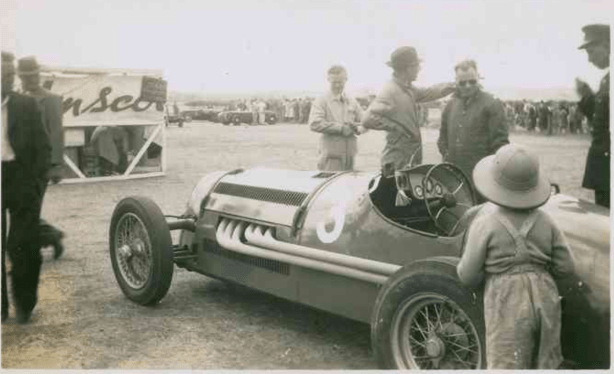
The carefree nature of the 1950 Nuriootpa race paddock is contrasted by the formal attire of the day, young boy in the Pith Helmet is impressed by Charlie Dean’s Maybach 1…
The first post war Australian Grand Prix in South Australia was held in the Barossa Valley. Not on the daunting Lobethal road circuit where the 1939 event had been run, but just down the road on roads at Nuriootpa.
The circuit was basically a square layout of 3-miles on flattish land. A permit for Lobethal couldn’t be obtained but one for Nuriootpa was thanks to the intervention of some prominent local businessmen including John Hill-Smith of the Yalumba wine family.

Graham Howard’s ‘History of The AGP’ described the circuit…
‘There was a slight uphill section along the (Nuri) Main Street, followed by a right hand corner onto a downhill section back into the countryside…This led to an Ess at a narrow bridge, after which the road ran straight to an intersection around which were collected the finish line, the pits and – on the next straight after the intersection – the start line. There was a vineyard to the left…but enough grazing paddocks for parking etc…’
The starting straight led to two fast right hand sweeps after which the road then led west by way of a pair of gentle Esses…to a T Intersection…then via a left-right sweep across another narrow bridge, into the Main Street again. There were some very bumpy parts…the roads just wide enough for two cars to pass readily…’

The Sporting Car Club of SA ran the event to the Australian Automobile Association’s decree, the winner was the competitor finishing in the fastest time but otherwise in the best traditions of the AGP at the time, the event was a handicap and awards were made on that basis. Geddit?
The main contenders for the race were primarily cars I have written about before so I won’t go through the detail, here are some links if you want to refresh your memory: The Maybach, driven by its creator Charlie Dean; https://primotipo.com/2014/12/26/stan-jones-australian-and-new-zealand-grand-prix-and-gold-star-winner/ ‘Black Bess’, the Ford Ute V8 Spl driven by its builder, Doug Whiteford; https://primotipo.com/2015/05/05/doug-whiteford-black-bess-woodside-south-australia-1949/
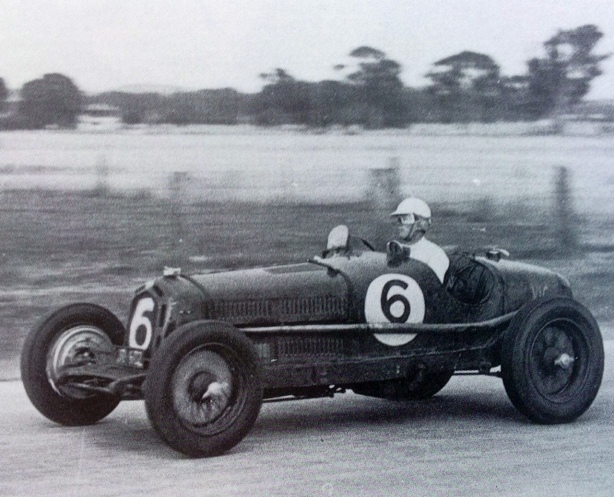
The ex-Alf Barrett Alfa Romeo Monza, was by the time of the Nuriootpa event owned and driven by relative novice Rupert Steele. https://primotipo.com/2015/02/20/alf-barrett-the-maestro-alfa-romeo-8c2300-monza/ Lex Davison, who would later win four AGPs started his Alfa Romeo P3, the scratch man was Tony Gaze’ 1935 2-litre supercharged Alta 56S, although he was not to start after dramas in a preliminary race, all these racers were Melburnians.
Fastest resident South Australian was Harry Neale in Eldred Norman’s, extraordinary ‘Double Eight’ or ‘Double V8’ which married the chassis of a World War 2 weapons carrier and a pair of single carb Ford V8s from army trucks. It had independent suspension on all four corners, 7834cc in total and was rated a good chance on a ‘point and squirt’ course like Nuri with slow corners and long straights. See the section below for details on this amazing car.

Australian Motor Sports described the race day scene…
‘Brilliant sunshine made the competitors paddock a colourful spectacle with racing cars in different hues, tender vehicles ranging from furniture vans and in which the Steele cars had been brought from Melbourne to the luggage trailer which Peter Damman had towed behind his racing Hudson the same distance. In a handy position near the course, Motors Ltd’s mobile service van was in constant demand with its stock of racing oils, spares and field workshop’.
‘Between the finish of the under 1500cc scratch race and the start of the Grand Prix, there was a brief interval for luncheon; then, as 1.30 drew near, cars were lined up in the continuation of the crossroads behind the starting straight, in preparation for the big race. Two spectators climbed up stepladders which they had brought to the course for private grandstands, and the three limit men were away…’

The race itself was diminished by the inability of Gaze to start, Davison’s retirement on lap one, having lost compression on two of the Alfas eight-cylinders and Dean’s withdrawal on lap 21 with magneto, overheating and braking problems.
What was absorbing was the battle between the Aussie Battler garage proprietor Whiteford in his carefully evolved and very well driven Ford V8 Spl, ‘Black Bess’ and the ‘Silvertail’ from Toorak, Rupert Steele in the aristocratic Alfa.
The latter had the edge on top speed, but the Ford, with more supple suspension was better suited to the South Australian country roads. Whiteford was a hard man as a driver, but the novice Steele was no slouch, he must have been a-natural to adapt to the GP car with his experience limited to a few hillclimbs and speed events in a Bentley road car.

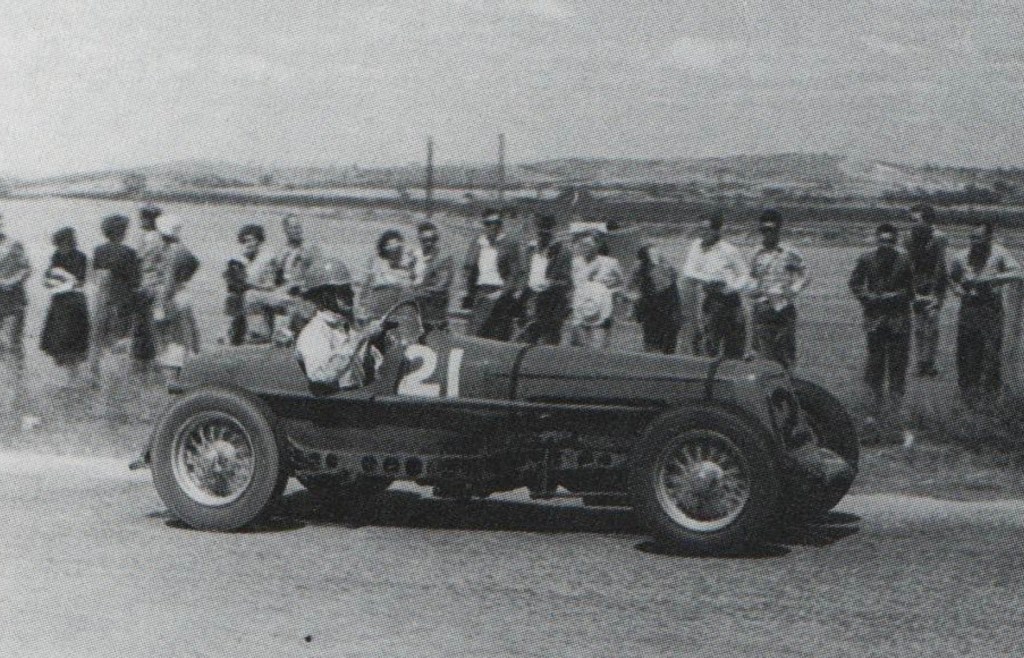
On lap 13 Steele ran out of road having passed a gaggle of MGs, he spun the big Alfa and stalled, then lost about 1 minute 49 seconds, hand-cranking the supercharged straight-eight back into life but his race was effectively run.
Whiteford won from Steele’s Monza and Jim Gullan’s Ballot Olds. The latter was first on a handicap basis from David Harvey and Ron Kennedy, both in MG TC Specials. Steele’s sporting focus was on horses for the rest of his life, sad really as his potential as a driver was clear, the Alfa was sold to ‘Racing Ron’ Edgerton by the end of 1951.
Doug went on to enjoy two more AGP wins in 1952-53 at Bathurst and Albert Park, and a career which went well into the 1970s as a works driver of Datsun sedans and sportscars.
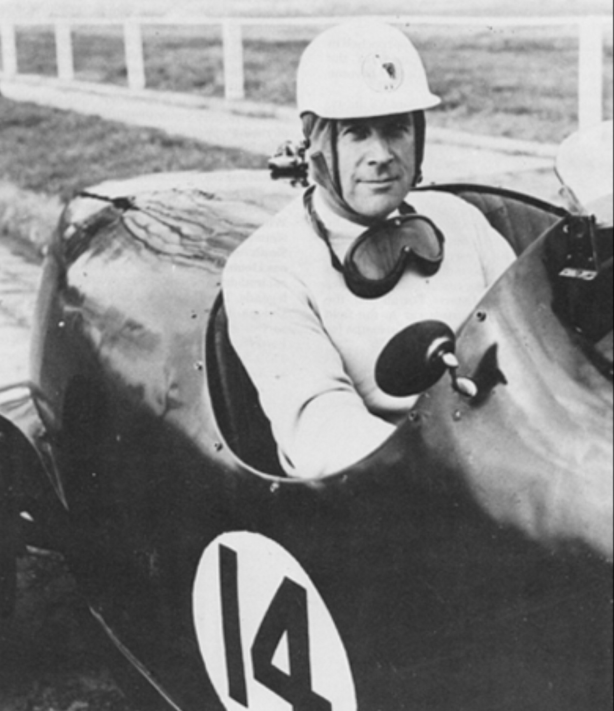

Other Competing Cars…
The stimuli for this article were several shots I found in the State Library of South Australia archive of the Dean Maybach, McKenna BMW 328, Jones HRG and other cars which competed that weekend.
I’ve done the Maybach to death in the Jones article referenced above, but here are some notes about the other cars with John Blanden’s ‘Historic Racing Cars in Australia’ providing much of the detail.

McKenna’s BMW 328 was raced by him all over Australia at Rob Roy, Fishermans Bend, Ballarat, Port Wakefield, Albert Park’s initial meeting in 1953 and as far afield as Southport on Queensland’s Gold Coast for the 1954 AGP. He overshot on a corner and rolled that day, the car passed through many hands before leaving Australia for Japan in the early 2000s.
Chassis # 85136 was brought into the country by John Snow, who acquired it on one of his regular trips to Europe, in 1937. A German General sold the car, Snow bought it on behalf of George Martin, president of the Light Car Club of Australia in Melbourne.
It finished the 1938 AGP at Bathurst in tenth, see my article on Peter Whitehead’s ERA which covers this race, Martin sadly had a fatal accident in it near Wagga Wagga on his return trip to Melbourne.
Their were two ‘racing 328s in period in Australia, both of which were involved in fatal road accidents. The other killed very talented racing driver Colin Dunne and his wife Billie at Phillip Island. It wasn’t a race accident mind you, but one which took place on the circuit between motor-cycle events.
By 1947 the 328 had passed into the hands of champion Geelong motorcyclist and dealer Frank Pratt. Pratt famously won his very first car race, the 1948 Australian Grand Prix held at Point Cook! He was aided by a favourable handicap, excellent driving and the extraordinary heat of the day which knocked out many of the more fancied runners.
Whilst new to car racing he was well familiar with intense competition. The car’s preparation by multiple AGP winner Les Murphy was also a factor. Some reports say that Murphy was extremely pissed off, he was originally entered to drive the car, and then was supposedly sharing it with Pratt, whose intention to drive the race solo soon became clear to Les once the arduous event was underway!
McKenna had a handicap of 9 minutes at Nuriootpa, but was unclassified.
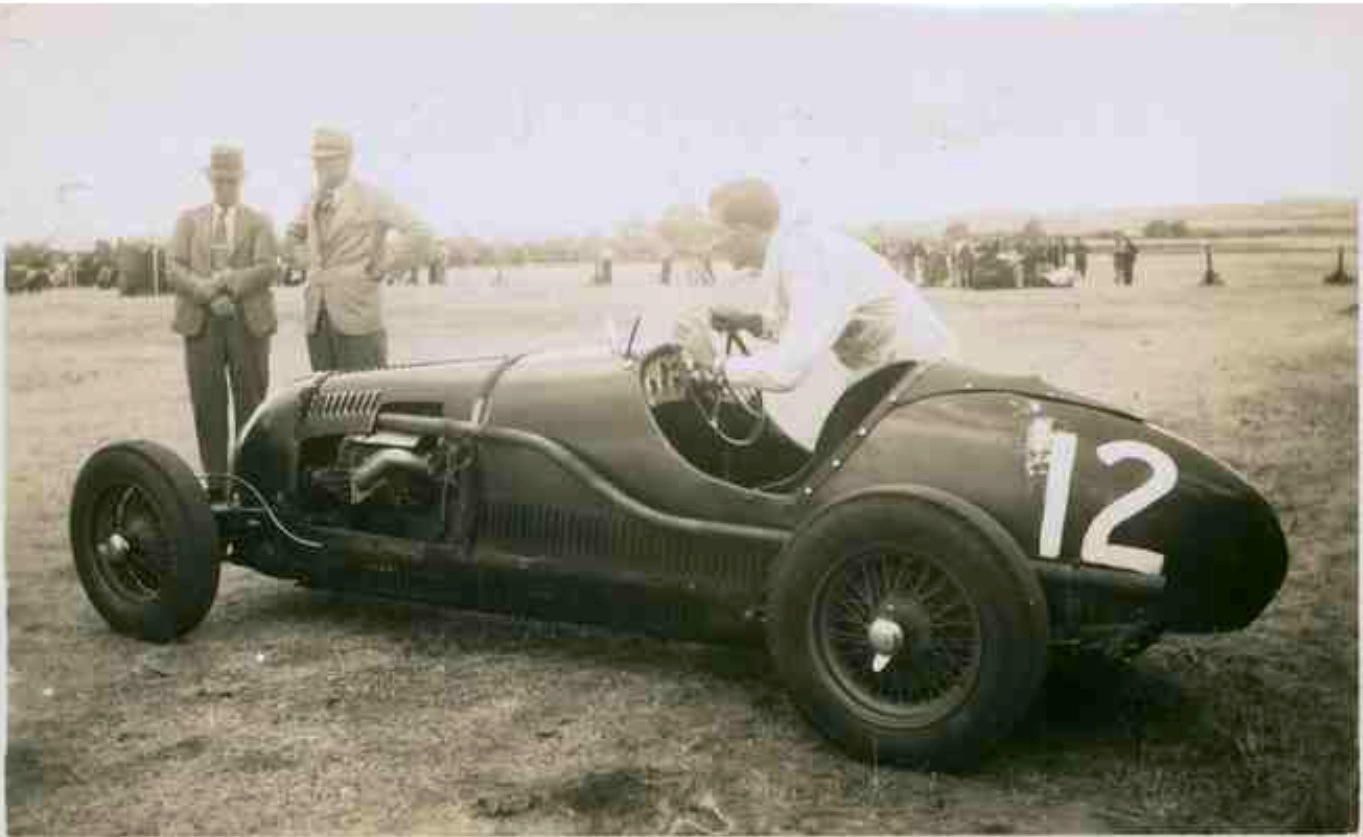
HRG ‘Bathurst’…
Tony Gaze brought the first HRG to Australia in 1947. The car was uncompetitive so Gaze specified future cars to be light, sports/open-wheelers with easily removable lights and guards so the cars could run as sports or racing cars in local events.
Brown and Dureau, a Melbourne trading firm who ‘Gaze was with’ imported the first car to these specifications in 1949, Stan Jones was the purchaser of the 1.5-litre, four-cylinder car (which had no chassis number).
He first raced it at Rob Roy in June, it was soon supercharged running at 12-psi of boost, racing it at Corio, Geelong in late 1949 and then entering the AGP at Nuriootpa.
In one of the preliminary races for under 1500cc cars Jones had a furious dice with fellow Melbourne motor trader/racer and later champion Bill Patterson – Bill was MG TC Spl mounted – both cars retired with overheating maladies. Jones’ car didn’t take the AGP start and Patto retired with head gasket failure; it was not a successful trip to the Barossa for either of them.
The car was sold later to Alan Watson in 1950 but was badly damaged by him and driven by Sil Massola in the 1952 AGP at Bathurst. According to the ‘Blanden Bible’ it was/is still in Australia.

Blurry Maybach in the ‘Nuri Paddock…
The shot is a bit fuzzy but still included for the atmosphere it shows, Charlie Dean in the paddock, the ‘Copper’ is keeping an eye on proceedings, Fiat Topolino behind the Maybach.

Other Entrants…
Curran Ford V8.
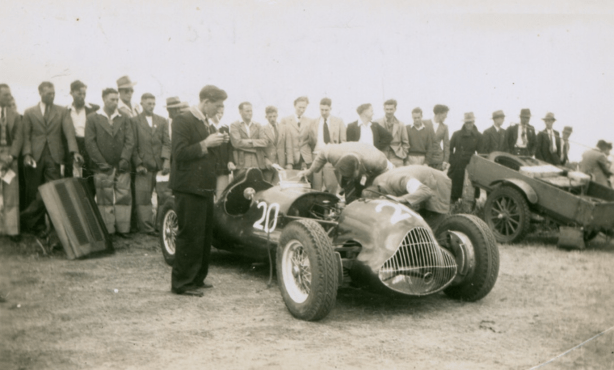
Regarded as one of the most specialised Ford side valve V8 specials built in Australia, Dennis Curran, then an apprentice, made many of the car’s advanced features including its independent front suspension and modified Minerva braking system. The attractive body appears to be in the style of the Alfa Romeo Alfetta 158/159 GP cars of the period.
The car was raced by Curran at the 1951 Narrogin AGP in WA, then in Bill Wilcox hands in the 1953-55 AGP’s as the ‘FLS’. The machine was then further modified by Frank Murphy on behalf of the owner, Melbourne car dealer Harry McLaughlin by fitment of a Lancia Lambda rear end, Jaguar XK120 gearbox and a new body.
A 5-litre Ford V8 was also fitted inclusive of Offenhauser heads and induction manifolds, it competed in this form at the 1956 Olympic AGP won by Stirling Moss at Albert Park. It was then known as the ‘Marchel’, the car then disappeared but was found by Noel Tuckey in 1980, restored and is now known as the ‘CWM Ford V8 Spl’ an amalgamation of the surname initials of the contributors to the cars evolution: Curran, Wilcox, Murray.
Bugatti Dodge.
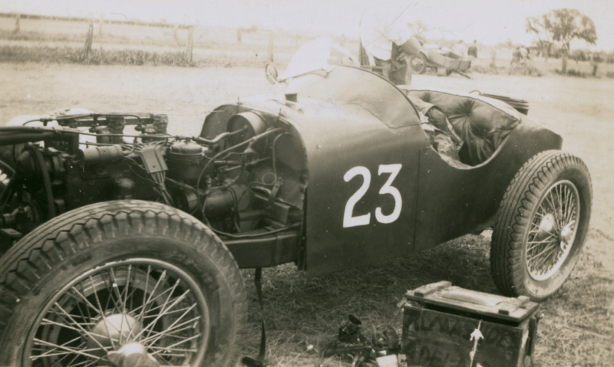
Ballot Oldsmobile.
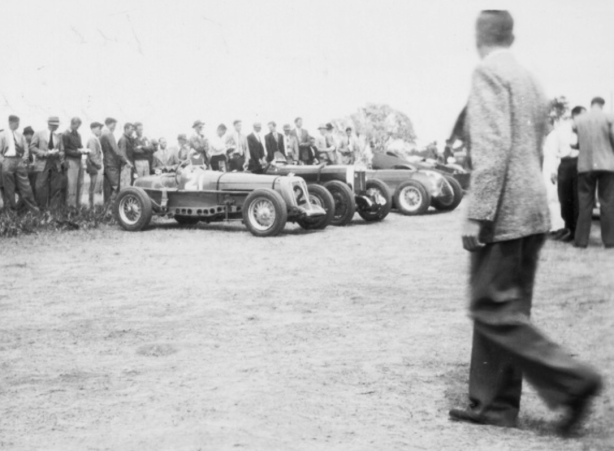
Jim Gullan replaced the Ballot Ford he had been racing in 1944 with a 2-litre Ballot bought nearby to his familiy’ garage in South Melbourne.
The Ballot engine was sold and replaced by an Olds six and ‘box, the chassis shortened by two feet and narrowed by six inches. It was lightened too, you can see the holes made in its longerons to do so. A body was made by Bob Baker in Melbourne – he built many racing bodies at the time – this Ballot is credited as the first. The sports two-seater was registered and commenced racing in 1946. It won the 1950 AGP handicap class as above.
Journalist and historian Ray Bell wrote about this car on ‘The Nostalgia Forum’, here is his detailed account of the construction and development of the car.
‘Jim Gullan’s Ballot will always rank as one of those cars that looks the part of an Australian Special. The raked nose, the heavily drilled chassis, steering wheel close to the chest and mandatory straps over the bonnet, its wire wheels carried a car that mixed European and American as well as any other. Fortunately the early life of the car is well detailed in Gullan’s book, ‘As Long As It Has Wheels,’ and there was plenty to write about as the Ballot Olds was to bring Gullan a number of successes.’
‘The car was bought in 1944, almost on a whim, it seems, after Gullan had sold the Indianapolis Ballot (by now fitted with Ford V8) early in the war. A 2-litre model with sohc engine and knock-on wire wheels (more important, according to Gullan), it had a poor body. He mentions four-wheel brakes with Dewandre servo, making it a 1926/28 model 2LT.
Soon after buying it a workmate offered money for the engine, gearbox and radiator to fit into a Bugatti chassis. Said Gullan: “I suppose any engine was better than none..’ Having just the chassis left, he thought he’d build a copy of his favourite car, the ERA. He was reluctant to go for another Ford, having had bad experiences with the V8, so an ad for an Oldsmobile engine and box (unused spares purchased for a Taxi) overcame his problems. It was to have triple Ford carbies and extractors.
The chassis was made into a copy of a Bugatti chassis, was shorter and narrower, designed to be ‘strong in the middle,’ boxed and drilled liberally ‘as on the SSK’ for lightness. The original hubs were retained, but laced to smaller rims, the spring shackles were located at the front instead of the rear as Gullan drew on all the modern technology he could identify.’
‘Bob Baker built the body round an angle iron frame, which was screwed to the chassis with small reject aircraft bolts. A deliberate effort was made to reduce frontal area, hence the car’s low appearance. Quick-fill petrol and radiator caps were fabricated and instruments (like the carbies) came from army disposals’.
‘The Ballot name was retained, even though virtually only the axles and wheel hubs remained, because it made it simple to register the car. Just roll up and pay the money!’
‘Springs were fitted outside the chassis and there were torque stays to the front axle, with finned alloy drums off a spare 2-litre Ballot Jim had bought and sold. The first race was at Ballarat at the beginning of 1947, after which hydraulic shocks were fitted front and rear (‘to the horror of the Hartford purists!’) and hydraulic actuation of the brakes was arranged. For Lobethal 1950, (the event which is the subject of this article) which the car was to win on handicap, a specially made 3.5:1 diff replaced the original 4.1:1 unit. Jim had to do the design work for the gear cutter.’
‘Gullan was in business with one of his major opponents on the track, Doug Whiteford, and when Doug imported an Edelbrock cam and heads (he’d melted a pair of alloy heads at Lobethal in 1940!) Bruce Rehn copied the cam profile and lift for the Olds. By the time of the Point Cook AGP (1948) there was yet another higher lift cam and special ratios in the gearbox. As a result of the heat at Point Cook, with the Olds running so cool and well, the engine was bored 3/16”, while both cars were fitted with enlarged sumps with cooling tubes fitted. Then for Nuriootpa’s opening meeting in 1949 PBR made up special alloy brake shoes and backing plates. These were found to be bending the chassis, so some more work was required’.
‘The car was Gullan’s expression of all he’d learned from observing racing and running his own Salmson, Wolseley, Austin and Ballot V8. It was considered by Whiteford to be ‘too sensitive in the steering and brakes, difficult to drive.’ Gullan adjudged Black Bess to be ‘tail light, tending to wander at speed, with light and spongy steering and poor brakes.’
‘Considering just how it came together – the bits that just happened to be there, the chance acquisitions – it worked very well. Gullan was a handicap specialist, with his wife Christine timekeeping and acting as strategist, and they beat the handicaps with monotonous regularity. He comments that he just had to keep on making the car quicker to keep on beating them, so it was well developed when sold to Alan Watson.’
‘He mentions getting airborne over the top of the hill approaching Lobethal at 110mph, touching 116mph on the straight and holding it flat all the way from Lobethal to within sight of the pits at that early stage of its development. By the time it won the handicap section of the 1950 AGP it must have been a fairly quick car’ (Ray Bell)
The car passed through many hands over the next 20 years, it was raced as late as 1963 at Calder, Victoria. It has been used since 1970 in historic events, is still alive today I believe in Frank Moore’s Collection of Australian Specials in Queensland.
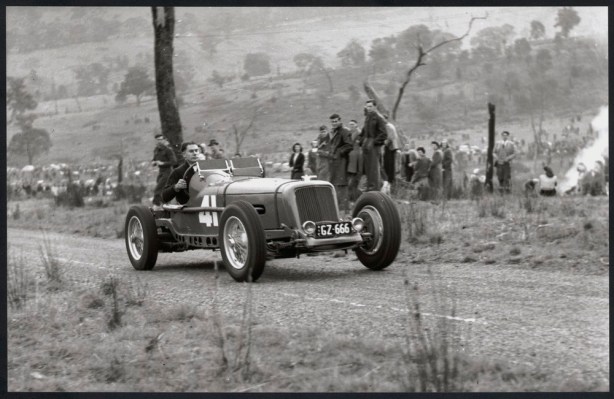
Double V8.

The following truncated account of this car is by ‘theotherharv’ on ‘The Nostalgia Forum’.
‘In 1946 Eldred was purchasing ex-army vehicles left behind by the Americans and selling them in Adelaide. While visiting Papua-New Guinea , he acquired a war-surplus Dodge weapons carrier chassis along with a host of Jeeps and Blitz trucks at an auction in Port Moresby.
Eldred used the Dodge to construct a race car – the ‘Double Bunger’, or more commonly ‘Double V8’ – it was built from the bodywork of an aircraft and a tubular steel chassis.
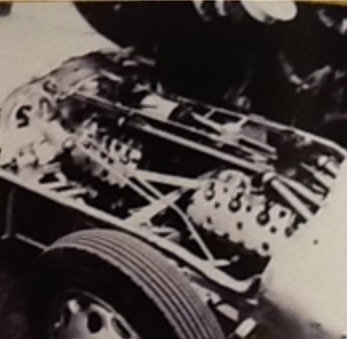
Power came from two Ford Mercury 239ci flathead V8 engines for a total capacity of 7,800cc. These engines were good for 100-110bhp each when run independently, giving Eldred some 200bhp in the Double V8. Engine cooling suffered despite radiators both in front and behind the driver with a tendency to overheat in long races. The engines were coupled flywheel-to-crank snout with a four-row chain drive and were timed to fire as a V16, with a Scintilla magneto providing the sparks.
This large 2500 lbs machine had independent suspension and water-cooled drum brakes supplied by four US made Toronto fuel pumps. The drum brakes produced spectacular clouds of steam as he applied them, despite being undersized for the task. The rear drums were built inboard, operating on the back axle and were additionally cooled by a fan worked by the tail shaft.

Road-registered, Eldred was frequently seen driving the Double V8 around the Adelaide hills, with trade plates tied with string or a strap around his neck! Between 1948-51 he drove the car successfully in hill-climbs and various race tracks in three States, the car was also driven long distances to compete at tracks such as Fisherman’s Bend, Victoria, a 900-mile round trip sans mufflers.
In addition to circuit racing, Eldred raced at Sellick’s Beach, South Australia where competition was undertaken between mile posts. An annual speed trial and motorcycle races were held on three kilometres or more of sand along Aldinga and Sellick’s Beaches up to 1953. The Double V8 won both the unlimited scratch race and the over 1500cc handicap race held at the beach by the Racing Drivers Association of South Australia in April 1950. This event drew more than 5,000 spectators. One incident with Harry Neale at the wheel of the Double V8 ended with the car deposited into the sea, ripping off the bodywork and leaving Harry sitting on the chassis, wet but unhurt!

Eldred’s can do, larrikin spirit was also evident in the way he once retrieved the telephone cables laid out for communication between officials at each end of the Sellick’s Beach strip. He fitted a bare rim to the Double V8 rear axle and fired up the twin V8s to power what must have been Australia’s most powerful fishing reel.

The Double V8 marked the start of Eldred’s entries in the Australian Grands Prix: in the January 1950 Nuiootpa Australian Grand Prix the Double V8 retired after only two laps.
The 1951 Australian Grand Prix was again run as a Formula Libre event in March at a 4.4 mile ‘around the houses’ road circuit at Narrogin, Western Australia. Eldred entered the Double V8, whilst leading on lap 7 of 24 it again broke down, this time due to suspension failure, leading to Eldred’s retirement from the race.
The car was sold in 1951 to Syd Anderson, proprietor of the Sydney Anderson Automotives used-car dealership in William Street Western Australia. During both Anderson’s and subsequent ownerships in WA the car was modified repeatedly.
Anderson raced the Double V8 extensively, including the following West Australian meetings: The Great Southern Flying 50 at Narrogin in March 1952, winning the scratch race for over 1500cc. The Northam Flying 50 meeting in April yielded a win in the three-lap scratch race for over 1500cc cars. At the Goomalling Speed Classic, on the road circuit in June he was fourth in the 15 lap handicap for Racing Cars, first in the 3 lap scratch race for racing cars over 1500cc and first in the 5 lap handicap for racing cars.


Anderson entered the Double V8 in the 1953 Johore Grand Prix in Malaya but retired from the race with overheating dramas. The car was then sold by Anderson to James Harwood, a navy veteran, musician and motor enthusiast in Perth.
Harwood tossed a penny with Anderson to decide the purchase price – either £50 or £100 – Harwood won. The vehicle was then towed to his business premises where Bill Strickland removed the two Ford V8 engines, which were sold. The Double V8 body was then placed outside James’ business as advertising, although it was removed a few days later at the request of Perth City Council.
In the period 1955-1957 Toby Carboni raced the car extensively in Western Australia before Keith Windsor bought the Double V8 body in 1957 and installed a V12 Lincoln Zephyr engine.
Lincoln produced these engines from 1936-1948, ceasing production nearly a decade before Windsor’s repowering of the Double V8. I’m not certain if Windsor used the 267ci, 292ci or 306ci engine (110-130bhp), though in any case it was a marked reduction from Eldred’s 478ci (~200bhp) double V8 powerplant.
Windsor debuted the V12 Double V8 in the Christmas Cup at Caversham in late November 1958, competing in the five-lap racing car scratch race for over 1500cc cars, although he did not place in the top three positions. Sadly, Windsor found the V12 vehicle was not manageable and subsequently scrapped it; if there is one car which would be welcome at Australian historic race meetings it is most certainly this stunning creation!
After the Double V8, Eldred bought a 1936 Maserati Type 6CM.
MG K3…

Otto Stone’s car, out after completing only one lap.
Healey Elliott…

The car behind the Healey Elliott is a Nash Ambassador. Donald Healey built 101 of these cars – Elliott refers to the body builders – Healey provided the ladder frame chassis to that firm to clothe, the engine was a Riley 2.5-litre pushrod-four, the car for a time was the fastest four seater in the world. They were built from 1946 to 1950, suspension used trailing arms at the front, and a live axle at the rear suspended by coil springs front and rear.
Etcetera…
Rupert Steele.
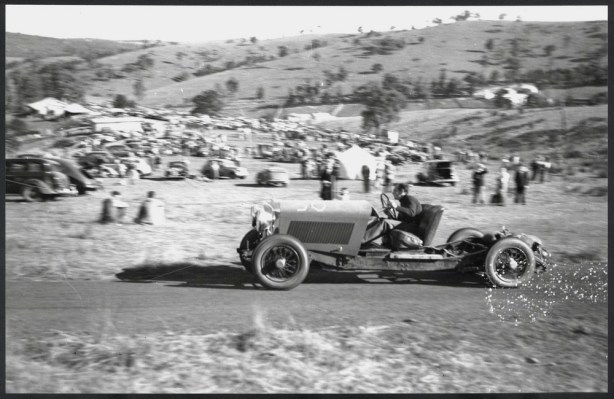
Rupert Steele contesting a Rob Roy Hillclimb in his Bentley devoid of bodywork in 1948. The step up from this lumbering tourer, he only did one circuit race in the car, to the Grand Prix Alfa Monza must have been immense.

Bibliography…
Graham Howard ‘History of The Australian Grand Prix’, John Blanden ‘Historic Racing Cars in Australia’, Australian Motor Sports January 1950, Stephen Dalton Collection, Motormarques, Ray Bell, The Nostalgia Forum (TNF), The Adelaide Advertiser 3/1/1950
Photo Credits…
Publications as above, State Library of South Australia, John Blanden Collection, George Thomas, The Nostalgia Forum, Stuart Jonklaas Collection
Tailpiece…

Ron Kennedy from Don Cant, both in MG TC Spls, finished in fourth and third places respectively.
Finito…
Thankyou Mark, Fantastic History,austerity post war hand built, scavenged parts, ingenuity and they were reasonably quick, Fantastic Kind Regards Steve.
Thanks Stephen, this blog is a journey for me too, my pre-1955 Australian Racing History is not flash, am enjoying the learning experience very much, M
That wonderful image of the three MGs looks a lot like it was taken at the Lobethal circuit. Nuriootpa was (is) somewhat less undulating. 1948 South Australian 100 perhaps. The race numbers check out against the details on the Wikipedia page for that race.
Thanks Rob, you may well be right, I lived in SA for 3 years but I am not a local enough to know. The competition numbers work for both events. Can’t easily put my hands on the source document or website to check either! Mark
It is worth comparing the scenery in the MG image (above) to the that in the image at http://trove.nla.gov.au/ndp/imageservice/nla.news-page2659870/print, which is from the 1948 South Australian 100 at Lobethal. A better quality reproduction of the latter is available at http://www.speedwayandroadracehistory.com/adelaide-lobethal-circuit.html
Cheers,
Rob
Rob, many thanks its definitely the same stretch of Lobi road as you say! i have deleted the shot, i have had a fossick around to see where i got it originally but cannot see it, doesn’t matter, its wrong so we fix! I have an article ready to go on the Victor 36/37 ‘AGP’ which i will upload soon if you have an interest in the SA Road Circuits, fantastic as they were/are. thanks again, mark
[…] https://primotipo.com/2015/07/10/1950-australian-grand-prix-nuriootpa-south-australia/ […]
[…] here for an article on this AGP including the HRG; https://primotipo.com/2015/07/10/1950-australian-grand-prix-nuriootpa-south-australia/ and here on Patto; […]
[…] 1950 AGP article here; https://primotipo.com/2015/07/10/1950-australian-grand-prix-nuriootpa-south-australia/ […]
[…] Despite his inexperience, he gave Doug Whiteford and his Ford V8 Special, Black Bess, a serious run for their money in the 1950 Australian Grand Prix run on the Nuriootpa roads in South Australia’s Barossa Valley. This event is covered here; 1950 Australian Grand Prix: Nuriootpa, South Australia… | primotipo… […]
Mark,
The photo above of MG No 33 leading MG No 35 is captioned “Don Cant from Ron Kennedy, both in MG TC Spls”, however the Official Programme has Kennedy as No 33 and Cant as No 35. An image published with the AGP meeting report in Australian Motor Sports magazine, January 1950 also has Kennedy as No 33 and Cant as No 35.
Cheers,
Rob Bartholomaeus
[…] Grand Prix at Ardmore aboard Maybach 1 of course. Click here for more on the Double Eight here; 1950 Australian Grand Prix: Nuriootpa, South Australia… | primotipo… and within this piece; Sellicks Beach, Adelaide… | […]